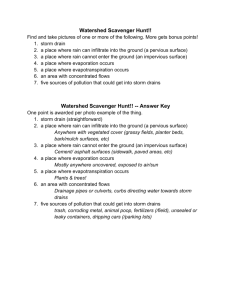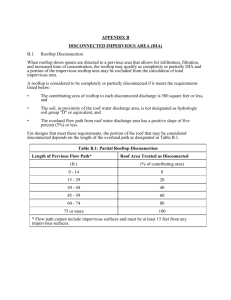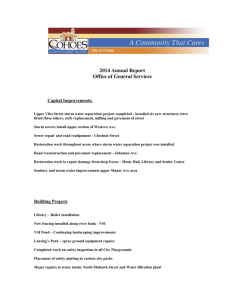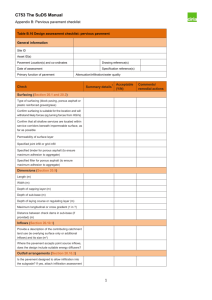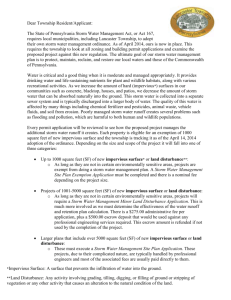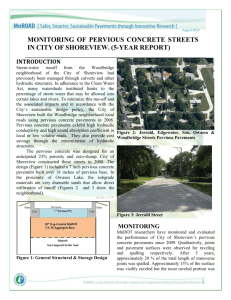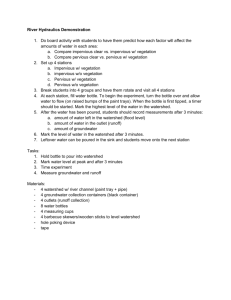Stonnwater ManagementIPerviollS Pavement Systems
advertisement
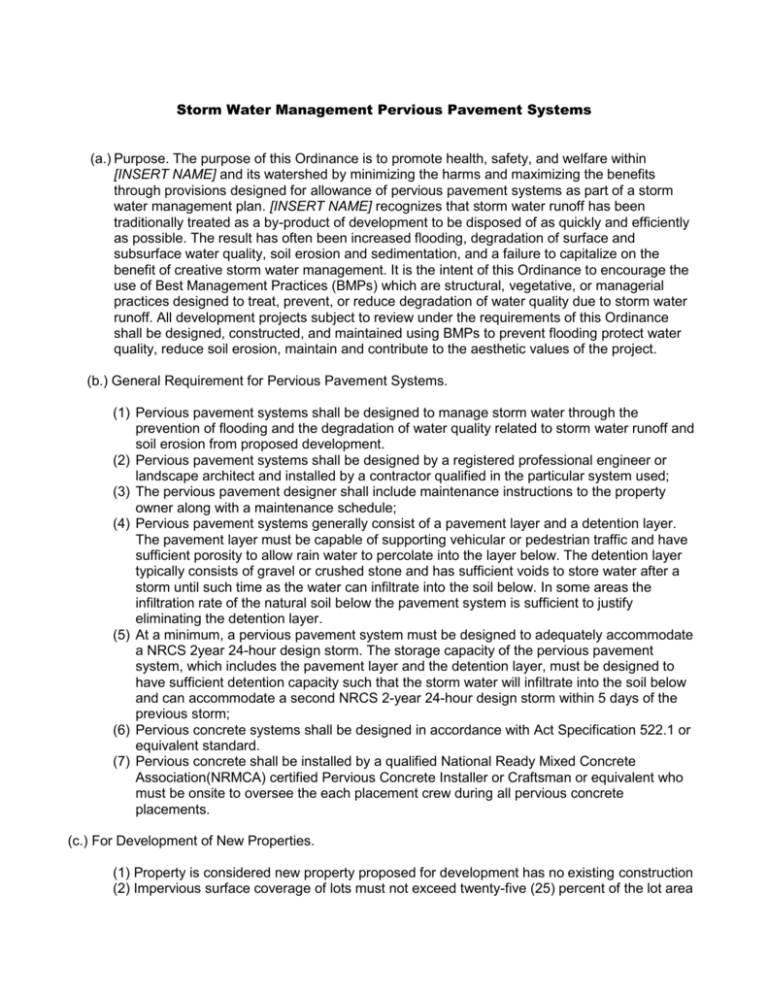
Storm Water Management Pervious Pavement Systems (a.) Purpose. The purpose of this Ordinance is to promote health, safety, and welfare within [INSERT NAME] and its watershed by minimizing the harms and maximizing the benefits through provisions designed for allowance of pervious pavement systems as part of a storm water management plan. [INSERT NAME] recognizes that storm water runoff has been traditionally treated as a by-product of development to be disposed of as quickly and efficiently as possible. The result has often been increased flooding, degradation of surface and subsurface water quality, soil erosion and sedimentation, and a failure to capitalize on the benefit of creative storm water management. It is the intent of this Ordinance to encourage the use of Best Management Practices (BMPs) which are structural, vegetative, or managerial practices designed to treat, prevent, or reduce degradation of water quality due to storm water runoff. All development projects subject to review under the requirements of this Ordinance shall be designed, constructed, and maintained using BMPs to prevent flooding protect water quality, reduce soil erosion, maintain and contribute to the aesthetic values of the project. (b.) General Requirement for Pervious Pavement Systems. (1) Pervious pavement systems shall be designed to manage storm water through the prevention of flooding and the degradation of water quality related to storm water runoff and soil erosion from proposed development. (2) Pervious pavement systems shall be designed by a registered professional engineer or landscape architect and installed by a contractor qualified in the particular system used; (3) The pervious pavement designer shall include maintenance instructions to the property owner along with a maintenance schedule; (4) Pervious pavement systems generally consist of a pavement layer and a detention layer. The pavement layer must be capable of supporting vehicular or pedestrian traffic and have sufficient porosity to allow rain water to percolate into the layer below. The detention layer typically consists of gravel or crushed stone and has sufficient voids to store water after a storm until such time as the water can infiltrate into the soil below. In some areas the infiltration rate of the natural soil below the pavement system is sufficient to justify eliminating the detention layer. (5) At a minimum, a pervious pavement system must be designed to adequately accommodate a NRCS 2year 24-hour design storm. The storage capacity of the pervious pavement system, which includes the pavement layer and the detention layer, must be designed to have sufficient detention capacity such that the storm water will infiltrate into the soil below and can accommodate a second NRCS 2-year 24-hour design storm within 5 days of the previous storm; (6) Pervious concrete systems shall be designed in accordance with Act Specification 522.1 or equivalent standard. (7) Pervious concrete shall be installed by a qualified National Ready Mixed Concrete Association(NRMCA) certified Pervious Concrete Installer or Craftsman or equivalent who must be onsite to oversee the each placement crew during all pervious concrete placements. (c.) For Development of New Properties. (1) Property is considered new property proposed for development has no existing construction (2) Impervious surface coverage of lots must not exceed twenty-five (25) percent of the lot area (3) One-Hundred (100) percent of the total area covered by pervious pavement systems designed to allow the infiltration of water may be considered pervious; (d.) For Re-development of Existing Properties. (1) Property is considered existing property if the property proposed for re-development has existing construction. (2) Existing properties that do not exceed the maximum allowed impervious surface for new properties shall meet the requirements for development of new properties. (3) Existing properties that exceed the maximum allowed impervious surface for new properties may construct new impervious surfaces if the proposed new impervious surface meets all setback, height and other regulations of this ordinance and if one of the two following conditions is met: i. The applicant removes existing impervious surfaces at a ratio of one and one-half (1.5) square feet removed for everyone (I) square foot added and restores these areas to a pervious surface. Applicants are encouraged to replace existing impervious surfaces with natural vegetation at the I.5 to I ratio, or, replace existing impervious surfaces with pervious pavement systems at a ratio of at least one and one-half (1.5) square feet converted for everyone (1) square foot of new impervious surface being added; ii. The applicant removes existing impervious surfaces and restores those areas to a pervious surface at a I to I ratio and in addition, submits a comprehensive storm water management plan that emphasizes infiltration and onsite retention of storm water for at least the NRCS 2 year design storm event through a combination of methods including buffer strips, swales, rainwater gardens, pervious pavement systems and other low impact development methods. The storm water management plan must be designed by a registered professional engineer or landscape architect and installed as designed by a qualified contractor. (4) One-hundred (100) percent of the total area covered by pervious pavement systems designed to allow the infiltration of water may be considered pervious; (5) A survey shall be submitted showing calculations of the exact dimensions of all existing impervious surfaces and of the lot before and after completion of the project; (6) In replacing existing impervious surfaces with surfaces designed to be pervious, the applicant must give priority to replacing those surfaces closest to natural bodies of water (lakes, ponds, rivers, streams or ocean) or those surfaces where the replacement is most likely to improve storm water management; (e.) Streets and Access. (1) Resident streets shall be designed with the minimum required impervious pavement width needed to support travel lanes; on-street parking; and emergency, maintenance, service vehicle access, and function based on traffic volumes. (2) Pervious pavement systems shall be considered a viable option for paving residential streets. (3) The total length of residential streets reduced by examining alternative street layouts to determine the best option for increasing the number of homes per unit length. (4) Street right-of-way widths shall be designed to reflect the minimum impervious pavement required to accommodate the travel-way, the sidewalk, and vegetated open channels. (f.) Parking (1) Base parking requirements on the specific characteristics of the property use. (2) Reduce all overall impervious area associated with parking lots by providing compact car spaces, minimizing stall dimensions, incorporating efficient parking lanes, and using pervious pavement systems. (g.)Site Design (1) Direct rooftop runoff to pervious areas such as pervious pavement systems, open channels, or vegetated areas and avoid routing rooftop runoff to the roadway and the storm water conveyance system. (2) Create a variable width, naturally vegetated or pervious buffer system along all drainage ways that also encompasses critical environmental features each as the 100-year floodplain, steep slopes, and wetlands. (3) Minimize clearing and grading of woodlands and native vegetation to the minimum amount needed to build lots, allow access, and provide fire protection. (4) Conserve trees and other vegetation at each site by planting additional vegetation, clustering tree areas, and promoting the use of native plants. (5) The use of pervious pavement systems for paved areas is encouraged. (6) New constructed storm water outfalls to public waters must provide for filtering or setting of suspended solids and skimming of surface debris discharge. Pervious pavement systems may be used as one method to achieve this requirement (h.) Maintenance Inspection (1) [INSERT NAME] shall ensure that preventative maintenance is performed by inspecting all storm water management systems. (2) Inspection reports shall be maintained by [INSERT NAME] for all storm water management systems. (3) Inspection reports for storm water management systems shall include the following i. The date of inspection; ii. Name of inspector; iii. The condition of: (a) Vegetation or filter media; (b) Fences or other safety devices; (c) Spillways, valves, or other control structures; (d) Embankments, slopes, and safety benches; (e) Reservoir or treatment areas; (f) Inlet and outlet channels or structures; (g) Underground drainage; (h) Sediment and debris accumulation in storage and fore bay areas; (i) Any other item that could affect the proper function of the storm water management system. (4) Description of needed maintenance. After notification is provided to the owner of any deficiencies discovered from all inspection of a storm water management system, the owner shall have 30 days or other time frame mutually agreed to between [INSERT NAME] and the owner to correct the deficiencies shall then conduct a subsequent inspection to ensure completion on of the repairs. (i.) Applicability (1) All development located within the jurisdiction of [INSERT NAME] must meet the minimum standards of this ordinance for storm water design. (2) Any project in this jurisdiction which has obtained building permits on or before [Date] shall be exempt from the requirements of this ordinance. (j.) This ordinance shall take effect and be in force from and after [Date]
